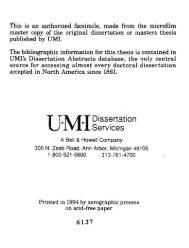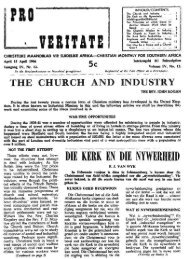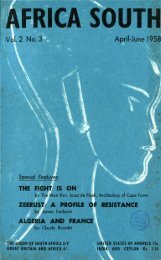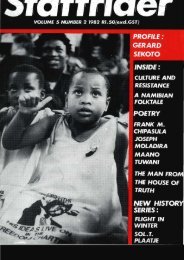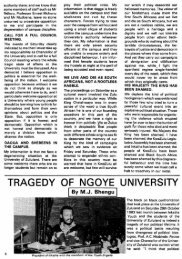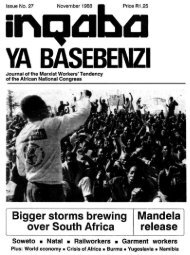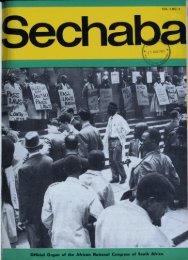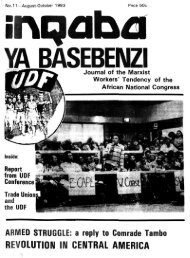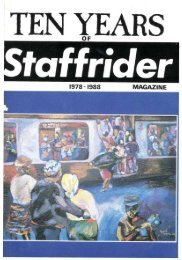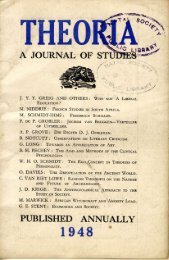Inqaba ya basebenzi Number 2 April 1981 - DISA
Inqaba ya basebenzi Number 2 April 1981 - DISA
Inqaba ya basebenzi Number 2 April 1981 - DISA
You also want an ePaper? Increase the reach of your titles
YUMPU automatically turns print PDFs into web optimized ePapers that Google loves.
The unceasing vibrant strength<br />
and unshaken determination of the<br />
black youth movement are unmistakeable<br />
signs, together with the<br />
awe-inspiring black workers' movement,<br />
that the fortress of racialist<br />
domination and unhindered bosses'<br />
terror has begun to crack.<br />
Wrapped in the entire experience<br />
of conquest, the rise and growth of<br />
naked white national and capitalist<br />
dictatorship, the black youth movement<br />
arose with all the scars suffered<br />
by the movement for class and<br />
national liberation.<br />
Black school and student youth,<br />
an uncontrollable and grudging<br />
by-product of capitalist exploitation,<br />
experienced and continue to experience,<br />
together with their parents, a<br />
consistent ruthless policy of intensified<br />
racial baasskap and capitalist<br />
exploitation—both in the racialist<br />
schools and in the bosses' factories,<br />
mines, kitchens, and farms. Since<br />
conquest, this has been their policy.<br />
The process of perfecting a<br />
complete regimentation of black<br />
workers, the system of cheap labour<br />
through influx control, the pass<br />
system and migrant labour—found<br />
their counterpart in the regimentation<br />
of racialist education; all this<br />
In the determined hands of white<br />
bosses' representatives.<br />
Bloody-minded and confident of<br />
their power and violence, symbolised<br />
by the spirit of the platteland in the<br />
police and military, the bosses<br />
transformed the mass of blacks into<br />
cheap labour and preparation for<br />
cheap labour. But this did not meet<br />
without the tradition of struggle<br />
against conquest.<br />
In South Africa, as around the<br />
by Ashraf Fortuin<br />
world, education has always been a<br />
tool serving the interest of the<br />
minority who control the factories,<br />
mines, farms, universities, and who<br />
control the state apparatus.<br />
Initially in the hands of settler<br />
missionaries, education was handed<br />
over to the white South African<br />
ruling class. This white bosses'<br />
dictatorship quickly developed<br />
education to suit the needs of<br />
unobstructed profit-making and<br />
racialist oppression.<br />
At the centre of their system of<br />
superior education for whites and<br />
inferior or no education for blacks,<br />
was rooted, right from the start,<br />
their whole unchanged interest and<br />
continuing intention i.e. to produce<br />
willing black slaves who would not<br />
rise above the ABC of culture and<br />
who would sing the 'praises' of being<br />
exploited day In and day out.<br />
The philosophy of their education,<br />
in black as well as white schools, is to<br />
succeed in producing the master over<br />
servant 'relationship', which in the<br />
factories and mines and on the farms<br />
is openly upheld by the vulgar<br />
domination of the management and<br />
foremen.<br />
Where the black worker can be<br />
fired and forcefully deported to the<br />
reserves, or Imprisoned; the black<br />
student or pupil Is ruthlessly abused,<br />
subjected to corporal punishment,<br />
expelled or Imprisoned.<br />
tit me iaCtor>, uic miitb",<br />
kitchens, and on the farms, the<br />
dictatorship of the bosses is represented<br />
by management, foremen and<br />
forewomen or the miesies who are<br />
supported by the labour bureaux,<br />
the pass office and the unrestricted<br />
power of the police.<br />
The bosses' apartheid state is<br />
represented in the school by the<br />
principal, headteachers and inspectors,<br />
who carry out the instructions of<br />
government policy.<br />
We shall not continue to be the<br />
doormat of conquest at the entrance<br />
of bosses 1 profits!<br />
Erupting in 1973, and subsequently<br />
immensely strengthened<br />
by the victory of the revolutions in<br />
Angola, Mocambique, and<br />
Guinea-Bissau, the black workers of<br />
Natal demonstrated their strength<br />
and announced to the bosses:<br />
'Filurauntu Ufeaadlklza!' ('Man is<br />
dead but his spirit Is alive!*)<br />
These strikes started the decade of<br />
the most brilliant national and class<br />
struggles of the working class and<br />
youth.<br />
Arising from under the bloody<br />
heels of baaskap the workers raised<br />
the battle cry which was taken up<br />
with the greatest exertion of the will<br />
to struggle and sacrifice by the<br />
renewed youth movement in the<br />
Soweto Uprisings of 1976.<br />
Caught between the process of<br />
healing past defeats, uncertain of its<br />
confidence and lacking the strength<br />
of past experience, the youth<br />
movement found the correct path<br />
under a storm of bullets, the<br />
hammer blows of baton charges, and<br />
the brutality of mass imprisonment.<br />
Responding to the call of their<br />
courageous children, the working<br />
class came out in two general strikes,<br />
lasting three days on each occasion,<br />
in which 500 000 to 700 000<br />
workers participated.



